|
|
|
Cracked Heat Exchangers, Causes and Solutions
What is a heat exchanger? These two words are nomenclature meaning the thin layer of metal that separates the good air that you breathe and the bad air comes from burning natural gas in a forced air heater or burning propane in a forced air heater. When natural gas is burning, it emits carbon dioxide, water vapor, carbon monoxide, nitrogen oxides and sulfur dioxide. While carbon dioxide (CO2) and water (H2O) not harmful to us carbon monoxide (CO), nitrogen oxides (NO, NO2, etc.) and sulfur dioxide (SO2) are. During the burning process, the heat exchanger contains these poisons and steers them towards the vent, which takes them up and out the roof safely away from you and your family. About 170 people a year die from non-automobile related carbon monoxide poisoning.
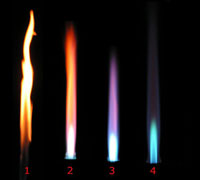
1. The tiki torch flame
|
This is carbonizing flame, which can soot up the firebox and vent through the roof. Left unchecked it can cause flue fires.
|
2. Too much fuel
|
This flame creates flames the whip up into the firebox and can touch the metal spot overheating it. This flames burns holes in fireboxes.
|
3. Too much oxygen
|
This can cause overheating the same as too much fuel.
|
4. The perfect blue flame
|
This is what the furnace is designed to run on.
|
All metal fatigues with time. The metal heats up, expands, then cools off, and contracts. This constant expansion and contraction, thousands of times a year, causes the metal to weaken and crack. The hotter the furnace - the more expansion, the more expansion - the more likely that the metal will fatigue and crack.
There is absolutely no known method for finding cracks 100 percent of the time.
The best way to locate cracks in heat exchanger is to visually locate a crack. Modern furnaces account for 80 percent to 90 percent of all forced air furnaces and a thorough inspection of the heat exchanger is not time feasible and is quite difficult at best.
Over the decades there have been many techniques including:
Smoke testing. A smoke generator is placed or blow into the heat exchanger, then the outside of the heat exchanger is visually accessed to watch for smoke passing through the crack.
Flame Testing. A salt solution is sprayed into the combustion chamber, a hole is drilled in the supply ducting, and a torch is held in the air blowing out of the hole to see if the flame changes color from the salt.
Odor testing. Oil of wintergreen or some other strong smell (peppermint) is sprayed into the combustion chamber (with the blower operating), then determine a crack if the smell permeates the home.
Tracer gas testing. A traceable gas is injected into the heat exchanger (methane, natural gas, propane, Freon), and a gas leak detector is used to detect faint amounts escaping.
Pressure testing. The openings in the heat exchanger are sealed, the blower energized, and a manometer (pressure gauge) is inserted inside the heat exchanger to see if a crack is allowing distribution air to blow into the heat exchanger.
Visual flame testing. Watching the flame when the blower comes on and watching for the flame color and shape to change as the air moves through it.
Almost all of these tests are severely flawed and lack properly methodology:
They assume that air leakage is one direction. Sometimes cracks lead to carbon monoxide entering the home and other times they lead to high-pressure air from the blower entering the heat exchanger flames.
They assume that the crack is open during the operation. Many time cracks do not open for long periods of time. Some are open when the furnace heat exchanger is cold or room temperature and other times only when the firebox is heated up.
They all assume that the service technician has the time and inclination to spend an hour or more looking for a defect in the heat exchanger.
Modern methods have their problems too.
Carbon Monoxide testing uses a CO2 Analyzer. Most cracks in heat exchangers do not vent carbon monoxide into the home so testing the air in the home for carbon monoxide does little to ensure a safe heat exchanger. Testing the combustion as it goes up the vent involves drilling hole into the vent and testing to see if the combustion gases change when the furnace blower motor turns on. A change is a definite positive for a rupture heat exchanger, but no change still doesn’t mean that the heat exchanger is safe.
A company back east invented a method of testing for cracks that involves the best method, visual location, and helps to extend that vision using small inexpensive cameras (similar to medical cameras only at a fraction of the price). This involves removing the blower assembly and spraying down the heat exchanger with a special water solution and then checking the burner compartment for water. The water can then be followed directly to the crack for proof positive. This only takes about 15 to 20 minutes and is called Hydro Scanning.
Hydro Scanning taken to the next level. Some companies use the hydro-scanning method, but have vastly improved it. They used a fluorescing dye developed by NASA (or at least funded by NASA) and mix this in the water. Then add a solution that enables the water to stick to the metal of the heat exchanger. This is much like the automotive and aircraft engine parts testing method magna-fluxing. Quick-easy-cheap and proof positive if your heat exchanger is safe or not. This method was actually invented at The Empire Family of Service and they are waiting for the patent rights at this time.
How to Stop a Heat Exchanger from Cracking
You cannot stop a heat exchanger from rusting or aging, but you cannot prevent that crack from occurring for many years to come. The simplest and easiest way to prevent a crack from forming is to prevent the heat exchanger from overheating. This means regular filter changes, proper size ducting, leaving the registers open and never blocking the return air register.
The manufacturer of your furnace mandated in the maintenance instructions that you have your furnace maintained by a qualified professional at least once a year. This is done to maintain the safety and efficiency of the furnace and the manufacturer has protected themselves from abused furnaces by nullifying the warranty in the event that the furnace was not maintained as described in the safety operating instructions. Every manufacturer requires yearly maintenance for safety and when this simple yearly act is ignored for a number of years the results can be catastrophic.
Dirty filters restrict airflow across the heat exchanger causing it to prematurely crack. The added heat stresses the heat exchanger and the results are a reduced life span. The lack of airflow across the heat exchanger means an inefficient heating cycle, a lack of btu’s, uncomfortable homes and high utility bills. Yearly maintenance truly pays for itself.
Do not store chemical near or around the furnace. This means no bleaches or cleaners as these, combined with the natural gas flames of the burner compartment, can cause a corrosive atmosphere to occur and lead to premature furnace failure.
Carbon monoxide: A mechanic’s approach
|
|
Examples of Cracked Heat Exchanger
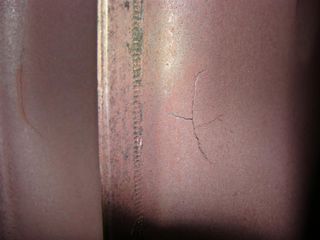 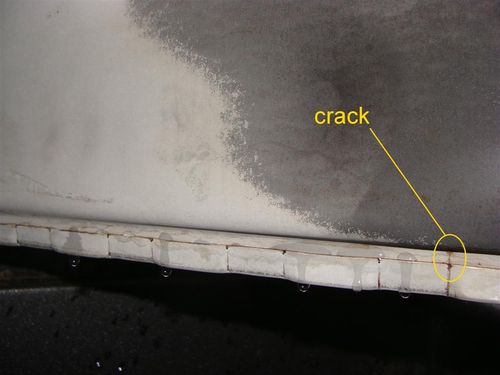 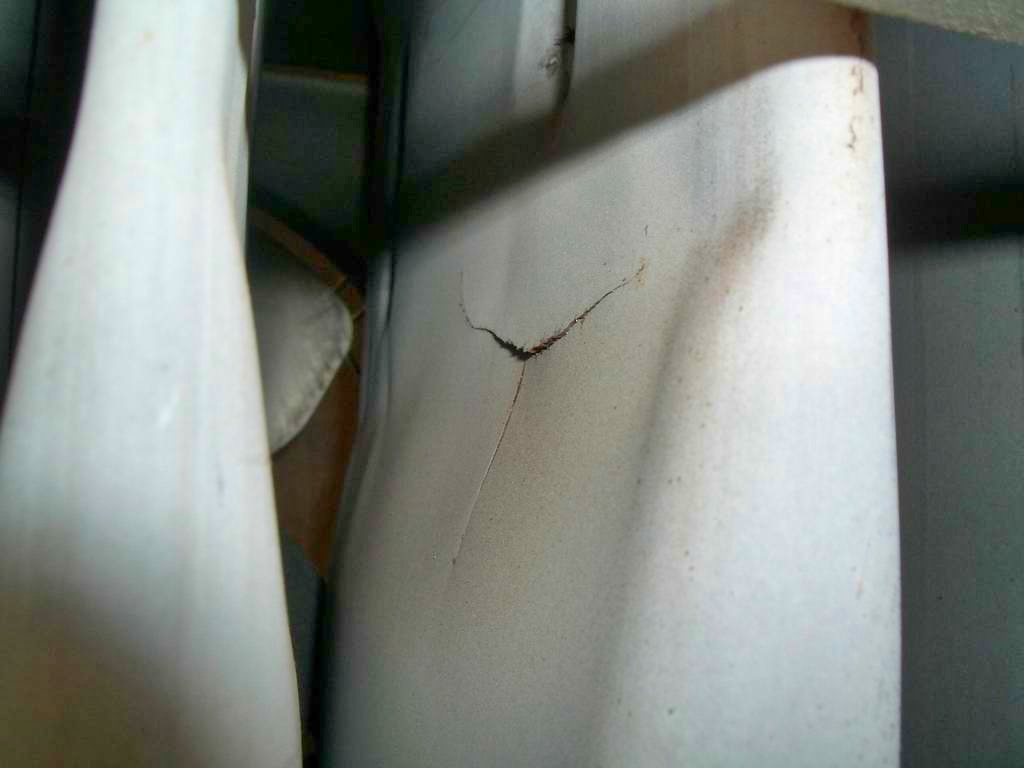
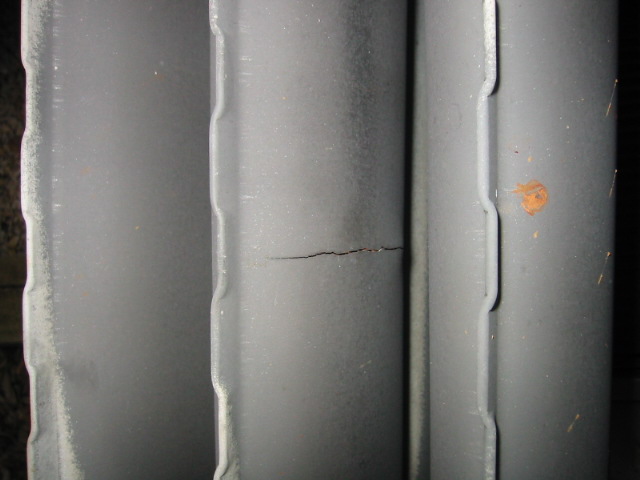 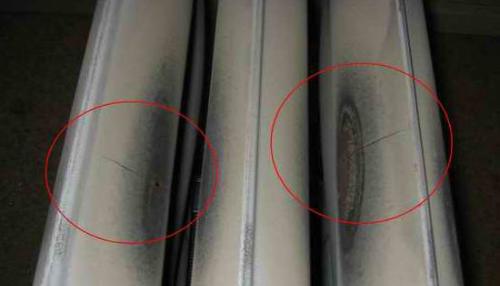 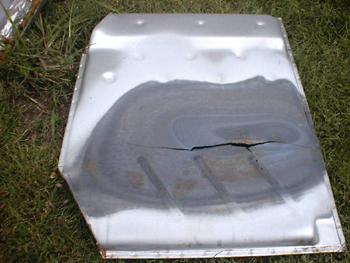
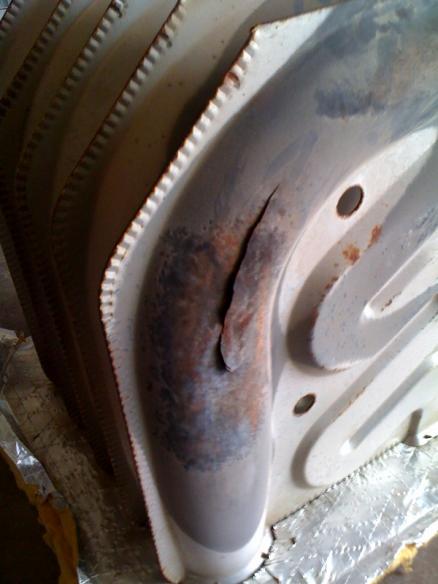 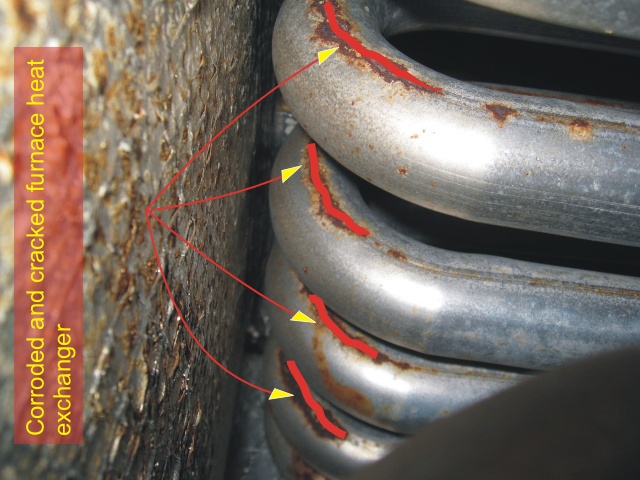 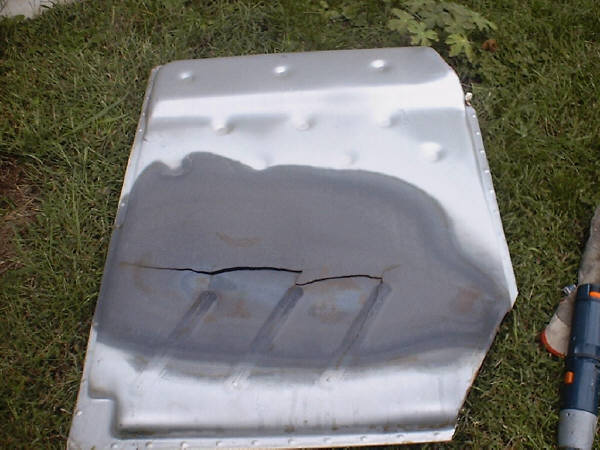
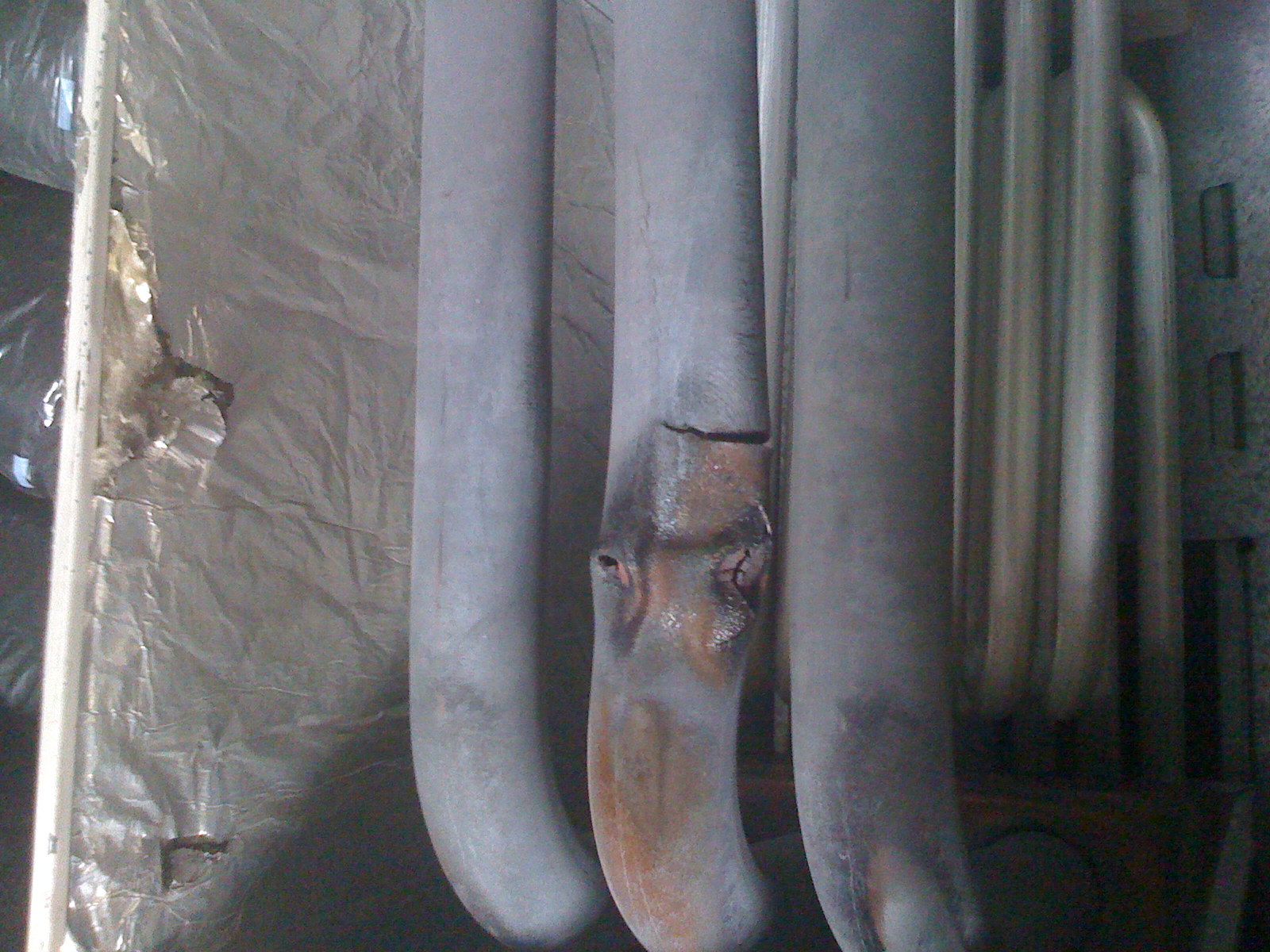 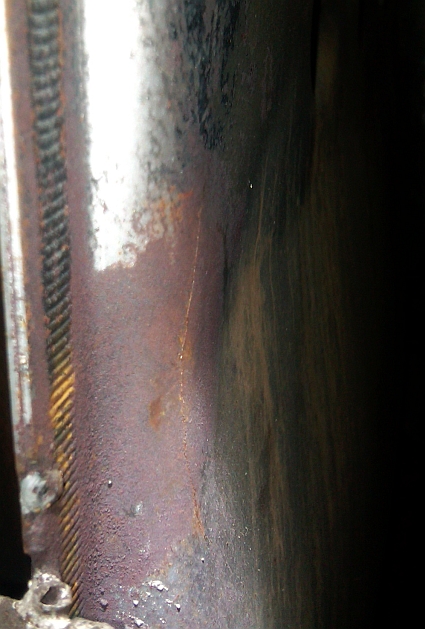 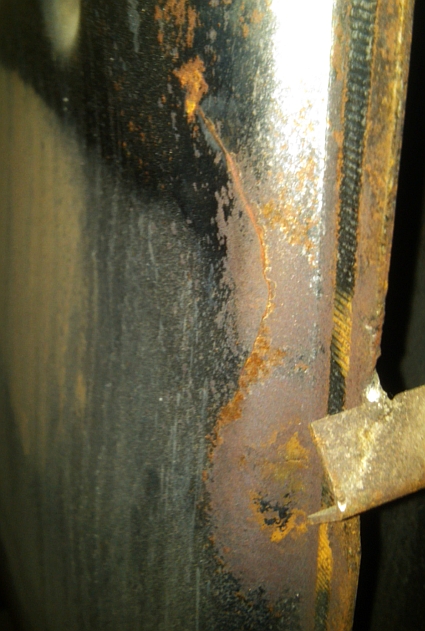
Recently my coworker inspected a gas furnace heating system at a local home that is experiencing black streak marks on the interior wall & ceilings and a light, mostly colorless film on various other interior items. This is important subject to touch on. Although there are various reasons that homes display this, this particular home was a pretty easy diagnosis. Before we go further into this, this phenomenon is known by a few different terms. The most common are: “thermal tracking”, “thermal bridging” & “ghosting”. It can be caused by smoking tobacco products or burning scented candles, inside the house. If there are just the black streak marks and they are primarily on or near exterior, perimeter walls or windows & doors, the cause can be poor insulation and/or air leaks. In the case of the house I inspected, the homeowners do not smoke or burn candles, of any kind. Also, the black streak marks were on all of the interior walls and there was also the presence of the filming of other interior objects, such as pictures & nic-knacks. Here, it is likely that these marks and deposits to be carbon monoxide or particles of partially burned hydrocarbons. The black marks could be a combination of fine dust particles & partially burned hydrocarbons, but it is the mostly colorless filming on interior surfaces that is something to be concerned about as it is likely to be caused by carbon monoxide. This is a serious situation as it can cause illness, and if serious enough, even death.
This situation it most likely caused by very fractures or cracks in the heat exchanger. This would allow the some of the products of combustion to mix in with the air stream and distributed throughout the home through the duct system. Since this particular furnace has only been in service for about 3-5 years, this condition is caused by age, and is most likely due to some kind of defect to or malfunction of the furnace. If you experience this situation, you can seek out the services of a public insurance adjuster to see if your particular case can be covered by your homeowner’s policy. Typically this would cover the costs of clean-up & restoration of the effected interior surfaces and the replacement of the heating system. In any case you should have this checked out, as it can be a very serious situation.
|
|
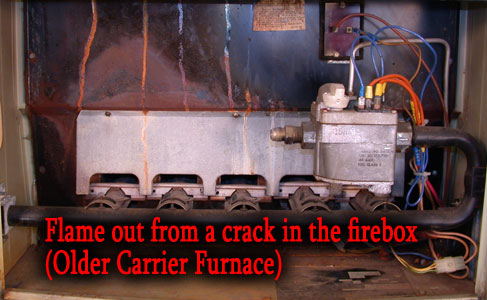 The number problem with a cracked heat exchanger is flame roll out, not carbon monoxide poisoning. The majority of furnace heat exchangers and furnace fireboxes today are designed with an induced draft motor. This motor is placed after the firebox and pulls the air through the heat exchanger exiting into the vent through the roof. The number problem with a cracked heat exchanger is flame roll out, not carbon monoxide poisoning. The majority of furnace heat exchangers and furnace fireboxes today are designed with an induced draft motor. This motor is placed after the firebox and pulls the air through the heat exchanger exiting into the vent through the roof.
This induced draft motor enables the heat exchanger to operate in a negative pressure environment or vacuum. Just before the burners turn on, the induced draft motor starts and creates a vacuum in the heat exchanger. The burners kick on and a timer starts. After so many seconds the blower motor for the furnace starts and pushes air under static pressure through the outside of the heat exchanger. This means that the air inside the heat exchanger it is experiencing negative air pressure and outside it the air is positive pressure. When a heat exchanger experiences a crack it generally will cause the greater air pressure from the larger blower motor to push air into the heat exchanger chamber causing all sorts of problems with the flame patterns. If the cracks become large enough, the air rushing through the flames will push the flames right out of the firebox and out the front of the furnace. This is the location of the gas valve, gas controls and often the thin flexible gas connector. The gas tubing prior to the gas valve does not have any safety controls that can act in the event of an emergency. If that this flexible gas connector melts or burns open, the furnace and surrounding area can become fully ablaze with very large natural gas flames.
Is it time to replace your furnace? Fill out a Repair or Replace Report Card
|
|
|
A website "ductworkinstallation. com" focus on providing information and services related to the installation of ductwork systems , which are the tubes used to distribute heated or cooled air throughout a building as part of an HVAC system; essentially, it would be a platform for individuals or companies specializing in designing and installing ductwork for homes and commercial properties, offering details on the process, and potential contractors to contact for such services.
Key points about ductwork installation websites:
Services offered:
New ductwork installation, ductwork repair, duct cleaning, duct sealing, airflow balancing.
Target audience:
Homeowners looking to install a new HVAC system, individuals experiencing issues with their existing ductwork, commercial property owners needing ductwork for large buildings.
Information provided:
Explanations on different types of duct materials, design considerations for optimal airflow, potential benefits of proper ductwork installation.
|
|